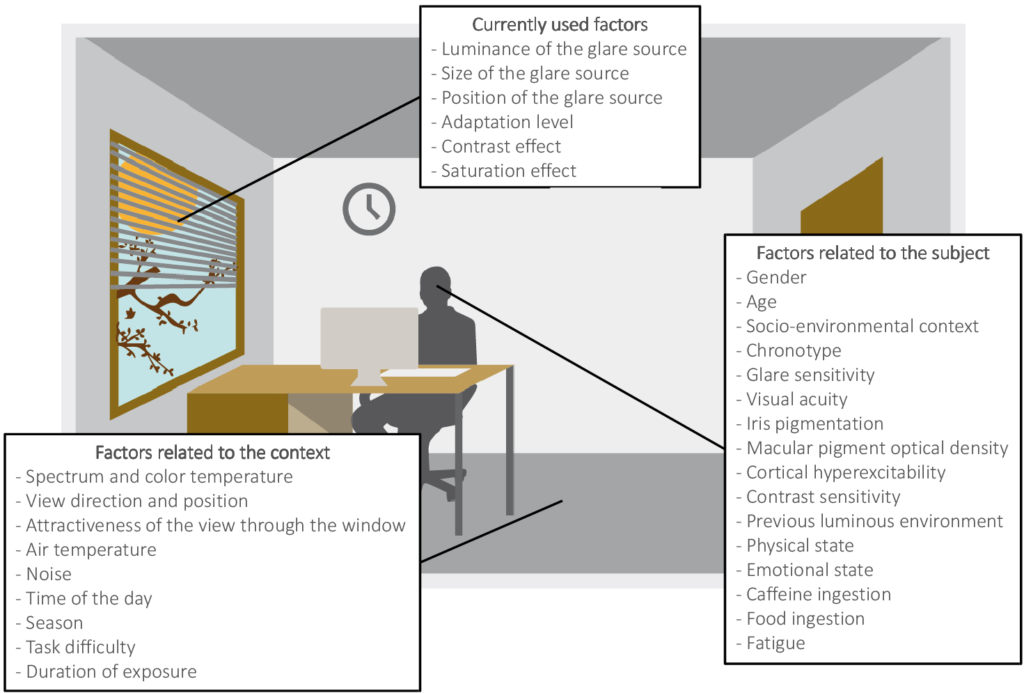2019 - Articles
DISCOMFORT GLARE PERCEPTION FROM DAYLIGHT: INFLUENCE OF THE SOCIO-ENVIRONMENTAL CONTEXT
Speakers
Ph.D. thesis by Clotilde Pierson, Université Catholique de Louvain (BE)
“Space and light and order. Those are the things that men need just as much as they need bread or a place to sleep.”
[Le Corbusier]
Exposure to light, and especially to daylight, has much to offer. Regarding buildings’ occupants, daylight has been shown to boost performance, improve sleep, provide a connection to the outside, increase comfort, lessen agitation, and reduce depression. Regarding buildings, daylight enhances the aesthetics of a space and improves its energy efficiency. On one condition, though: that it does not produce visual discomfort. In order to harvest the benefits of daylight, visual discomfort has to be minimized. Hence, discomfort glare from daylight should be predictable.

To date, more than twenty daylight discomfort glare models have been developed. However, none of them can consistently and accurately explain the large variation between subjects’ discomfort glare perception. Improving current models predicting discomfort glare perception remains a crucial step to move towards optimal daylighting design in buildings.
In this context, it is hypothesized that the prediction of discomfort glare perception can be improved by including relevant additional factors related to the context or to the subject in the models. The main research question that this study aims to answer is to determine whether one of these factors, namely the socio-environmental context of the subject, influences discomfort glare perception from daylight in office buildings. The socio-environmental context is defined here as the climate and habitat, including indoors and outdoors, to which a subject has been acclimatized, her/his behavior toward these elements, and her/his expectations about them. Two additional research questions aim at investigating other potentially influencing factors and potential experimental biases in order to guide further research in the field.
For this purpose, a field study was conducted in real office buildings located in four socio-environmental contexts, i.e., Chile, Belgium, Japan, and Switzerland. Discomfort glare perception evaluations, each consisting of a subjective assessment of discomfort glare from daylight and the measurement of the visual stimulus, were collected at the office desk of the 401 subjects who took part in the study. The raw data was processed to derive useful information, and cleansed according to specific rules to ensure data quality.
Different statistical analyses were conducted on the processed and cleansed data to answer the main research question. No statistically significant differences in the sensitivity to discomfort glare from daylight could be observed between the subjects acclimatized to the Chilean, Belgian, Japanese, and Swiss contexts. The results show therefore no evidence of an influence of the socio-environmental context of a subject on discomfort glare perception from daylight in office buildings.
Furthermore, the influence of several other factors on discomfort glare perception from daylight in office buildings was tested and the data was further analyzed regarding potential experimental biases in order to answer the two additional research questions.
A statistically significant effect was found for three factors, namely the self-assessed glare sensitivity, the attractiveness of the view through the window, and the indoor air temperature. From this result, it can be hypothesized that these factors could influence discomfort glare perception. Moreover, further analyses suggest that two experimental biases, namely the glare rating scales and the study type, could be influencing the results of studies on discomfort glare perception. However, since the study was not specifically designed to answer these two additional research questions, and in view of its limitations, no conclusion can be drawn on these last observations. They can, however, be used to guide the development of future studies.
In conclusion, this research provides no evidence that discomfort glare from daylight is perceived differently in different socio-environmental contexts. Research efforts in discomfort glare perception from daylight should therefore aim at improving prediction models by looking at other potential factors, such as physiological and environmental ones. Finally, future studies should also aim for the validation of reliable methods to study discomfort glare, and for the development of a unified methodological framework to promote the reproducibility of studies and the comparability of results.
You can download the thesis at: http://hdl.handle.net/2078.1/222924